On Wednesday morning we packed a small suitcase with a change of clothes, bagged our laptops and drove south to a near coastal town called Hyères. Since we wanted to explore Provence further afield and not have to drive back to Aix, we opted for a hotel along the D98, as a new base to explore. Hyères is a commune in the Var department of the Provence-Alpes-Cote d’Azur region, which is the oldest resort on the French Riviera, and is home to about 54,000 residents. Even before the Greeks and the Romans, it had been a Phoenician settlement, and during the Middle Ages a Templar commandry was based at the town.
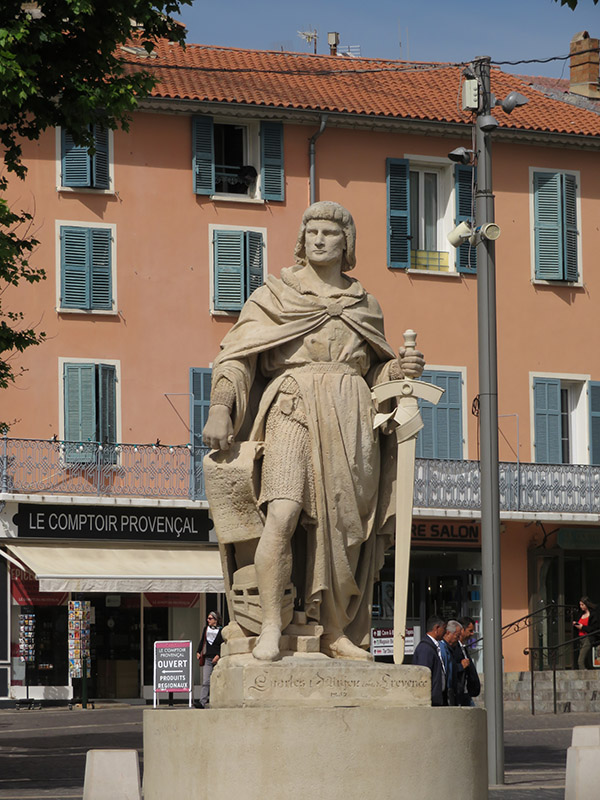 We arrived and entered an underground parking lot in the center of town, so we could explore. When we walked up the stairs, we came out upon a very large pedestrian plaza. There were food stands, and pigeons, but at that moment nearly deserted. We opted for a drink and shared a piece of baklava. At the end of the square was a statue of Charles 1 (1227-1285), who became the King of Naples and Sicily and the Count of Anjou and Provence. He was the youngest brother of King Louis IX of France.
We arrived and entered an underground parking lot in the center of town, so we could explore. When we walked up the stairs, we came out upon a very large pedestrian plaza. There were food stands, and pigeons, but at that moment nearly deserted. We opted for a drink and shared a piece of baklava. At the end of the square was a statue of Charles 1 (1227-1285), who became the King of Naples and Sicily and the Count of Anjou and Provence. He was the youngest brother of King Louis IX of France.
We left the square and walked up a nearby narrow alley lined with shops. Vendors put out tables laid with tourist items and local food stores offered herbs and seasonings, fruits and vegetables, meats, cheeses, and fresh fish on ice. At the furthest end we arrived at an old Templar tower. The bottom floor was an art gallery, but three flights up ancient stone stairs, there was a Templar display. And one more flight up there was a rooftop to look out over the city where one could see all the way to the Hyères port and the Balearic Sea.
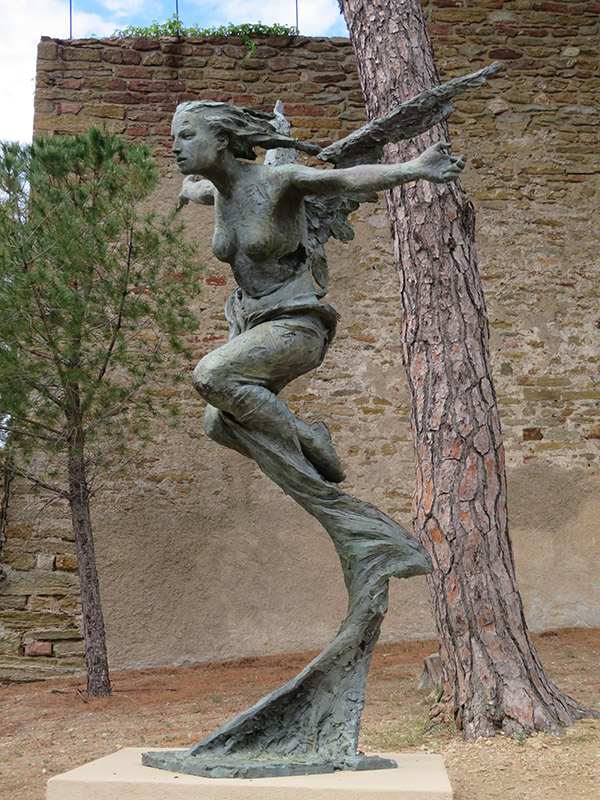 When we had seen what we wanted, we went back to the car and travelled further along the D98 to Bormes-les-Mimosas. On the way, we stopped near the top of the hill to get a view of the coastline far below. Where we parked, there was the ruins of the castle of the Lords of Fos and its chapel. In front of it was a unique statue.
When we had seen what we wanted, we went back to the car and travelled further along the D98 to Bormes-les-Mimosas. On the way, we stopped near the top of the hill to get a view of the coastline far below. Where we parked, there was the ruins of the castle of the Lords of Fos and its chapel. In front of it was a unique statue.
In Bormes-les-Mimosas it was market day, and the usual large parking lot for the town was filled with vendors, so all visitors had to slowly descend the windy climb and find a parking spot, then hike back up the road. Once back to the top of the hill, we walked through the tables, which sold mostly food items, but some tourist things like soaps and baskets. At the busiest turn of the road, there were two restaurants. We decided on Le Café du Progres for lunch. We got a table that gave us a view of the intersection with people walking by while fresh air gently flowed up from the water far below.
Vere ordered a chicken breast that had specks of black garlic with a flavorful sour cream, and herbed potatoes. I ordered the salmon with artichokes. This turned out to be an excellent meal. Not only was the salmon perfectly done, but it also came with a cooked slice of artichoke on one side, artichoke puree on the other, a slice of eggplant and a delicious lemon sauce over it all. When we finished, we crossed the street and Vere got a salted caramel ice cream cup to sweeten his tongue. Then on the way back Vere took a picture of the town nestled on the hillside.
Our next stop was to the large botanical gardens of Rayol-Canadel. This natural preserve is about twenty hectares of sloping hillside to the sea, with many paths running across the hillside. The gardens specialize in all different kinds of plants that are native to the Mediterranean, but also arid and subtropical places. The entire hillside has plants that fill the Var and Riviera coasts. At first it was a resort for wealthy landowners during the first part of the century. Then became a hotel-casino during the interwar period, a real estate project for tourism in the 1970s, and finally it was bought in 1989 by the Conservatoire du Littoral (Coastal Conservatory) with the sole aim of protecting the land from the construction frenzy of the end of the century. Now the entire area is managed by the Domaine du Rayol.
We parked as close as we could get, but still had to walk half a mile to the entrance to the park. It was warm with a bright sun, but we had our hats and sunscreen to protect us. We first went to a building that had not yet opened for the season, but a path led us around to the back patio where construction was occurring. Still, from there we had a great view of the sea and in the distance could see the Giens Peninsula closer in and beyond it the island of Hyères.
We took many winding paths, some open in bright light and some shaded. Large trees from the different arid and tropical zones helped shade us, and hundreds of tropical plants grew along the paths.
We chose a path that took us to a lookout over the ocean. Along the way we paused and looked back, where we had just stood on its balcony. Then we continued on our way along the edge of the cliff which had a wooden stick fence.
We at last reached the point with great views of the water and coastline. To describe the color – blue just doesn’t do it. It was more of an iridescent sapphire, with darker deeper teals. It splashed up against the rocks below with force. A view over another area showed a rocky beach with white frothy surf. The breeze was a perfect light coolness that pleasantly cooled our brows from the hike.
There were many gardens to explore, and it would be a hearty soul that traversed them all. We chose only a few from the total. There was the Canary palm garden, California garden, South African, Australian, Subtropical Asian, New Zealand, arid, Subtropical American, Mediterranean, marine, and citrus gardens. We were surprised how little was actually in bloom, since it was spring. Many plants had already bloomed and were turning brown. Either the gardeners had not trimmed away last winter’s seasonal plants that had withered, or the heat had come early to dry things out. We managed to find a couple of wild fields that had blooms with some red poppies, white and pink peonies, yellow broom, and some purple everlasting.
There are several buildings on the site. The Courmes Property was built in 1910 by a Parisian businessman, who designed a pleasure garden with palm trees, date palms, eucalyptus, agaves, and mimosas, which became the Hôtel de la Mer. In January 1940, Madame Courmes sold the estate to the famous aircraft manufacturer Henri Potez, and it became the Potez Estate.
Forced by the war to abandon his factories in Somme, France, Potez took refuge in Rayol with his family. The house was refurbished. Many servants provided service, while a dozen gardeners took over the garden. A majestic descent of stairs was made below a pergola. The garden then experienced its glory days. At first the Domaine du Rayol was no more than a summer residence. At the end of the 1960s, lacking personnel and proper maintenance, it was abandoned. Finally, the Domaine du Rayol was purchased in 1989 by the conservation company, and redesigned by landscape designer Gilles Clément, who planted floral landscapes associated with the regions of the world.
After tromping about the hillside for nearly two hours we were hot and tired, so we sat for a spell in the Gardener’s Café and shared a Mango/Banana/Coconut juice, then left the gardens for the long walk back to our car. We headed back to Hyères to get to our hotel for the night with reservations at the Hotel Almanare Plage. Our room and bathroom were small but adequate, and it had a balcony that overlooked the water. It is a complete Bio Hotel. It literally does everything a place can do with its water, waste, and energy, with bio cleaning products, eco designed beds and linen, organic local food, composting hens, even the recycling of cigarette butts (what they do with them, I didn’t ask.) They use no single-use plastics, have outdoor solar lighting, a green electricity supply, a charging station for electric cars, and much more. We had the superior “driftwood” room. They can even deliver dinners to your room.
With a dinner recommendation from our hotel hostess, we headed out past our hotel south of the harbor. We ended up at a small café called Know Where. A fun name. So we enter and the guy greets us in Italian. Vere answers him in Italian and they have a conversation. Seems the guy came as a cook to work the season one summer and ended up staying for thirty years. It is a pretty nice area to live. So here we are in France, in the Know Where café that serves Sushi and Yakatori and speaking some Italian. Then we see a car license plate on the wall from Costa Rica. So Vere takes a picture of it and sends it to friends of ours who now live in Costa Rica. The world is such a crazy place. But the food was good. Vere had cheese and chicken skewers with rice, and I had a shrimp and avocado roll. When finished, we said “ciao” to our host and took a walk to the end of the block. There we met the water’s edge with boats coming in, as it was at the end of the day.
This entire area has very large salt ponds that were once farmed for the salt by Italian immigrants, but now they have been left as shallow bodies of water. There is one large one with two long narrow spits of land each with a road that goes out to a long island with the salt field between them. The island itself, well almost an island, but still surrounded by water on three sides, might be considered more of an isthmus with a double tombolo (narrow sand bars) that connect it to the mainland. So we drove out on to the (is)land to watch the sunset, which has a small settlement. At the far north end it was closed off to a military area, so we returned and took the second tombolo back to the mainland. Along the way a small strip of low sand dunes bordered the road, and soon we were back at our hotel for the evening for the end of day sunset.
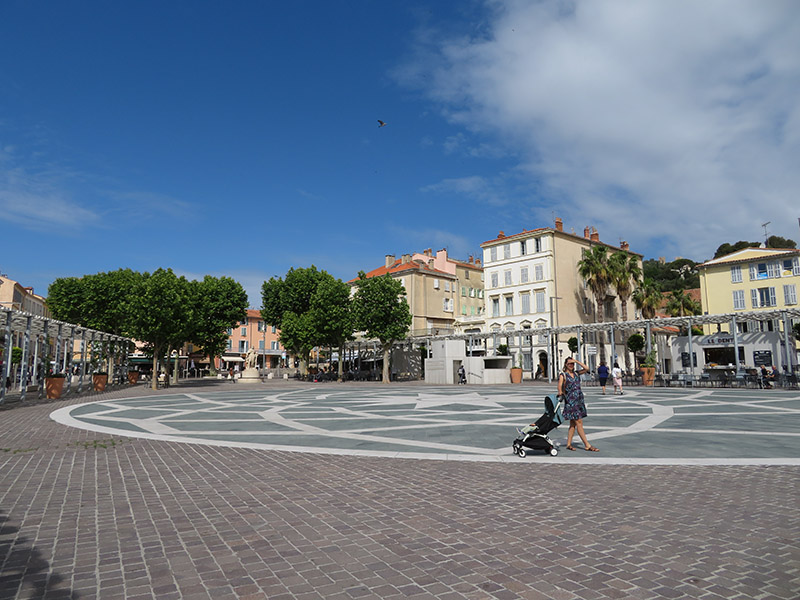
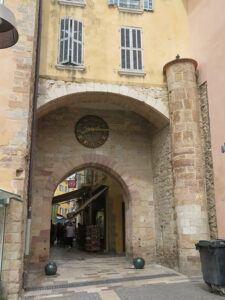
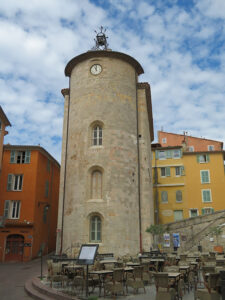
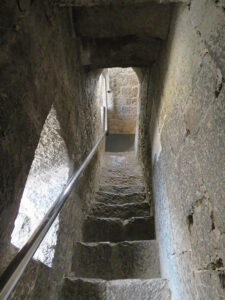
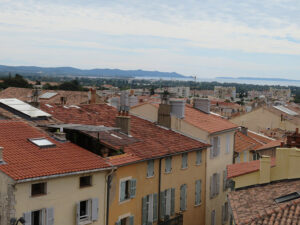

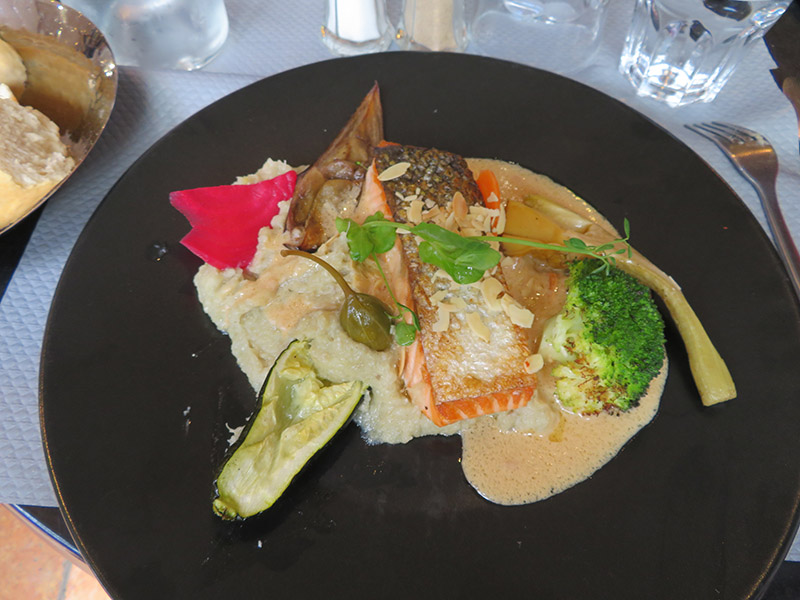

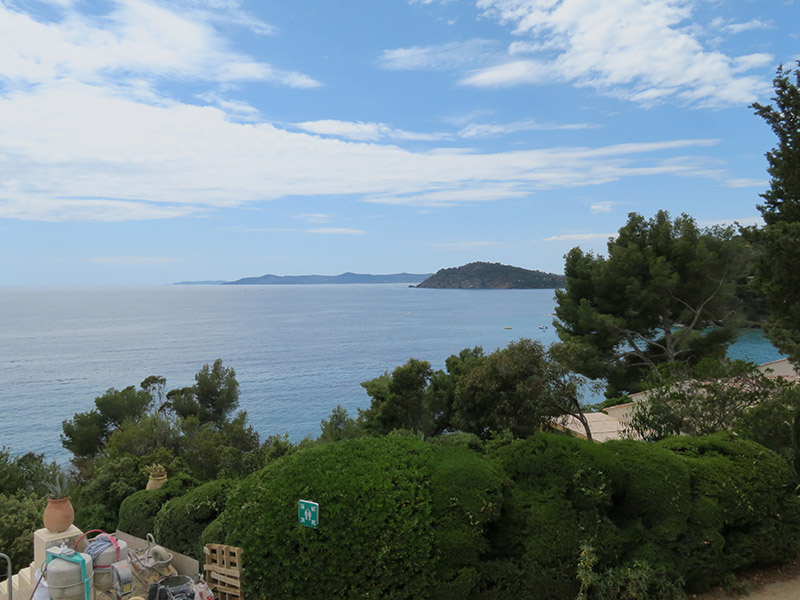
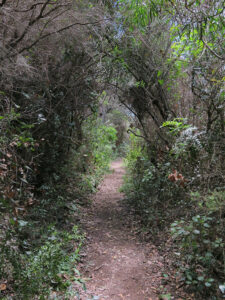
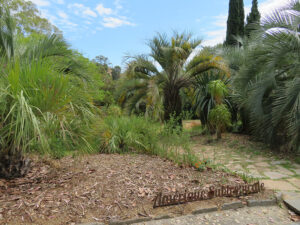
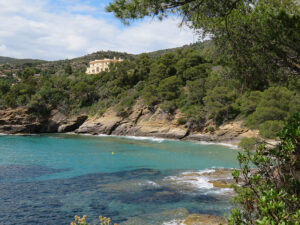
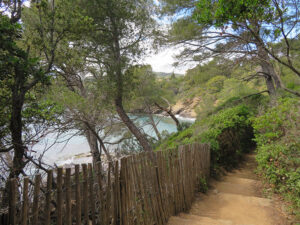
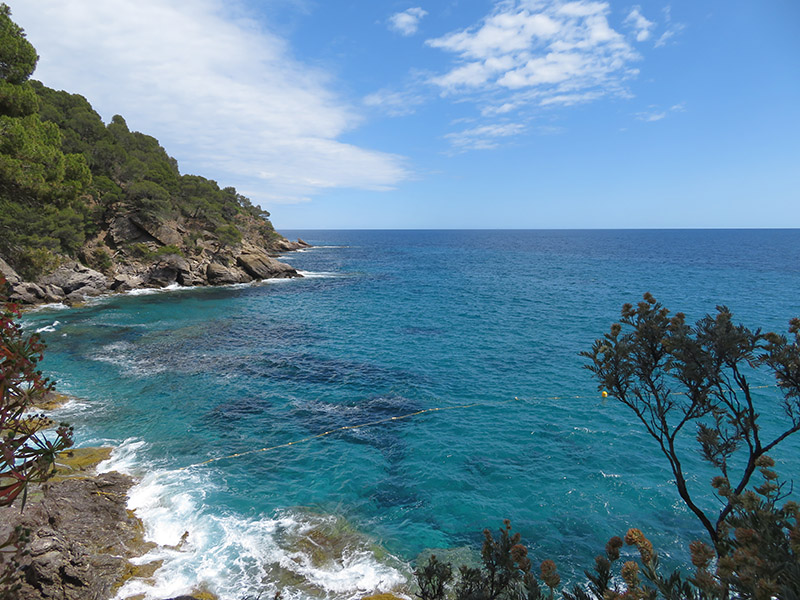
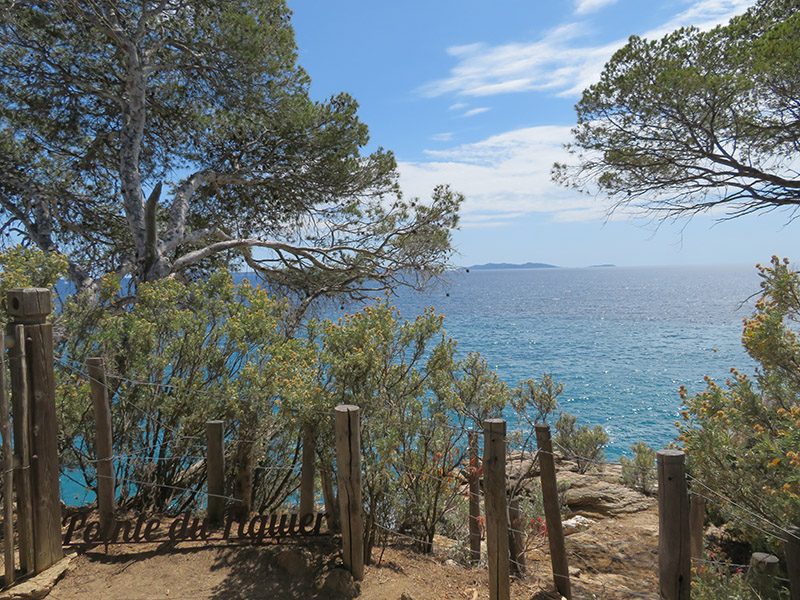
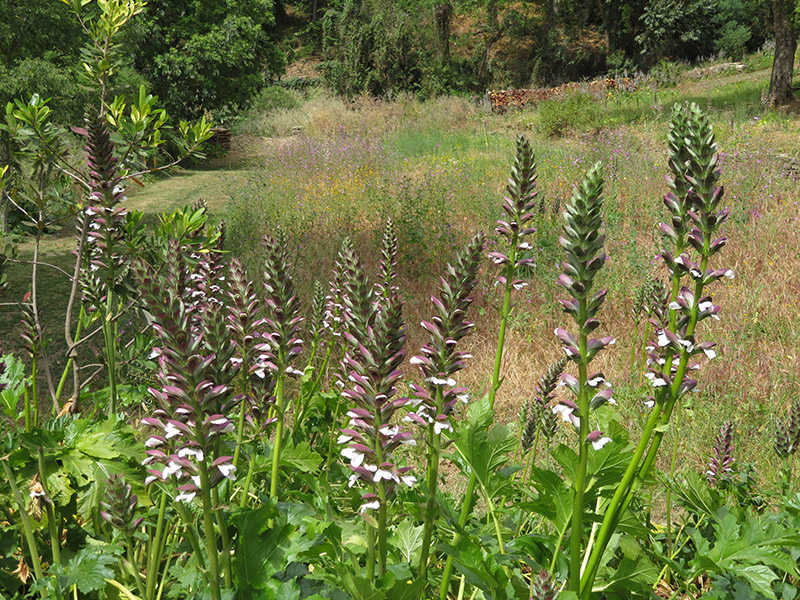

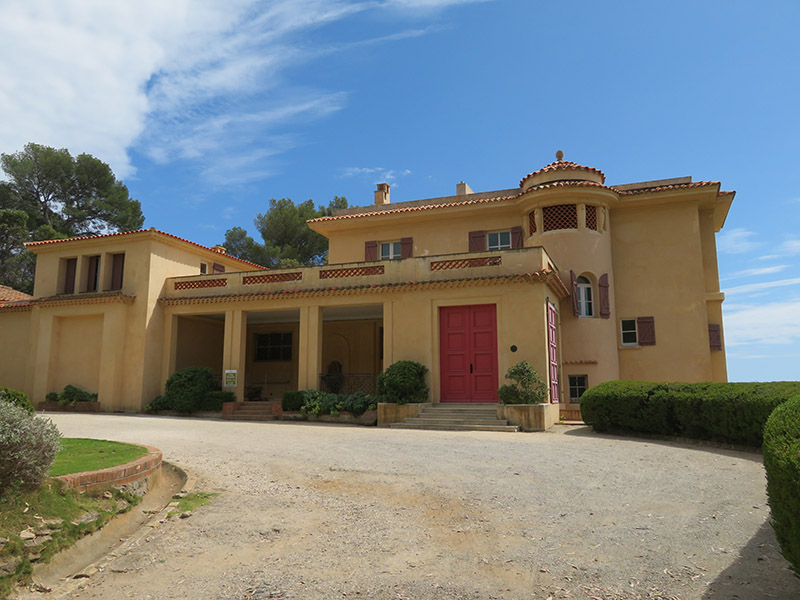
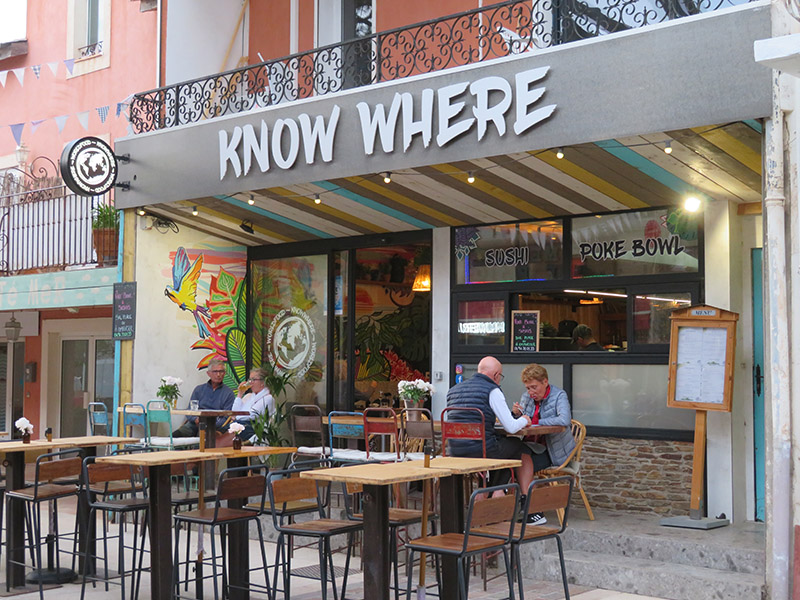

 The official website of Lita-Luise Chappell, writer on sex, magic, food, distant lands, and everyday life with articles, poetry, novels, travelogues, rituals, cookbooks, and short-stories.
The official website of Lita-Luise Chappell, writer on sex, magic, food, distant lands, and everyday life with articles, poetry, novels, travelogues, rituals, cookbooks, and short-stories.
